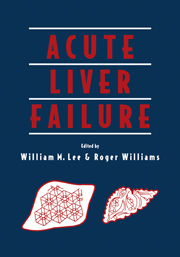Book contents
- Frontmatter
- Contents
- Preface
- Foreword
- Acknowledgments
- Contributors
- Part One Clinical Syndrome and Etiology
- Part Two Mechanisms of Disease and Multisystem Involvement
- Part Three Intensive Care Management
- 10 Medical management of acute liver failure
- 11 Circulatory derangements, monitoring, and management: heart, kidney, and brain
- 12 Brain edema and intracranial hypertension in acute liver failure
- 13 Management of infection in acute liver failure
- Part Four Transplantation
- Part Five Artificial and Bioartificial Liver Devices
- Part Six Other Applications
- Index
- Plate section
10 - Medical management of acute liver failure
from Part Three - Intensive Care Management
Published online by Cambridge University Press: 20 May 2010
- Frontmatter
- Contents
- Preface
- Foreword
- Acknowledgments
- Contributors
- Part One Clinical Syndrome and Etiology
- Part Two Mechanisms of Disease and Multisystem Involvement
- Part Three Intensive Care Management
- 10 Medical management of acute liver failure
- 11 Circulatory derangements, monitoring, and management: heart, kidney, and brain
- 12 Brain edema and intracranial hypertension in acute liver failure
- 13 Management of infection in acute liver failure
- Part Four Transplantation
- Part Five Artificial and Bioartificial Liver Devices
- Part Six Other Applications
- Index
- Plate section
Summary
INTRODUCTION
Over the past 25 years, a more thorough understanding of the unique problems of patients with acute liver failure has resulted in improved intensive care and better overall survival. The crucial management decisions for the patient with acute liver failure begin in the emergency room, and the outcome is frequently determined in the first 12 h. Thus, the overall outcome is determined by the initial management strategy adopted, as much as it is by the intensive care administered later on. Acute liver failure is not hard to diagnose, but because it is infrequent, the diagnosis is often missed by the first medical contact. For example, a young person presenting with acute hepatitis symptoms who is ambulatory and has a prothrombin time more than 4s prolonged should be considered to have developed one important warning sign for acute liver failure. The evolution to encephalopathy in this setting is not a certainty but is likely enough to warrant hospital admission for observation and management. Physicians underestimate the severity of illness in such cases either because they may not have seen a case recently, or because the age of the patient and their apparent excellent general health lulls them into a false sense of security. Moreover, the pace of deterioration in hospital is often extremely rapid and may surprise even the most experienced clinician. This is one situation where there is little time for contemplation or leisurely assessment.
- Type
- Chapter
- Information
- Acute Liver Failure , pp. 115 - 131Publisher: Cambridge University PressPrint publication year: 1996



